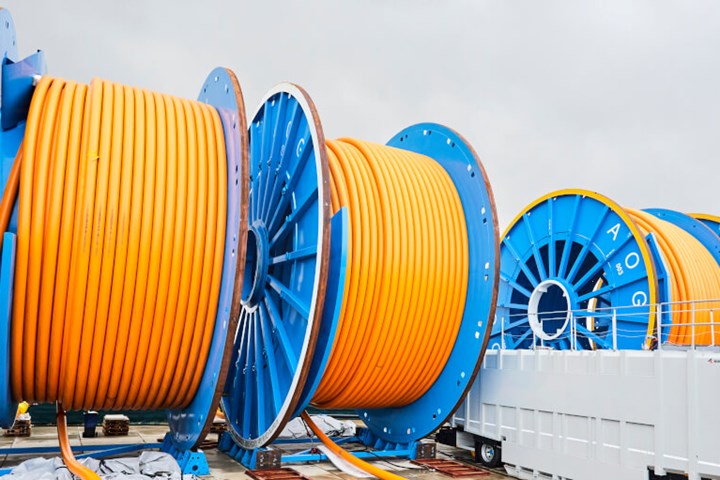Strohm thermoplastic composite pipes receive DNV certification, reported to have low carbon footprint
Strohm and Evonik’s carbon fiber/PA12 pipes are now fit to use for hydrocarbons transport. A lifecycle report also found the TCP pipes to have a 60% lower carbon footprint than an equivalent carbon steel pipeline.

Photo Credit: Strohm
Strohm (IJmuiden, Netherlands) and Evonik (Essen, Germany) have been awarded the full certification from DNV (Høvik, Norway), attesting that the unidirectional (UD) carbon fiber PA12 tape “Vestape PA12-CF” (PA12) used for Strohm’s 100% recyclable thermoplastic composite pipes (TCP) is fit to use for dynamic sweet and sour hydrocarbons, water and gas injection applications according to DNV-ST-F119.
The two companies, in partnership with the Netherlands Aerospace Centre (NLR, Amsterdam, Netherlands), have reportedly led the way in the development, qualification and supply of PA12 for TCP applications following an intensive investment and testing program over the past five years, in which the NLR provided the main composite testing facilities. The program served to develop a fundamental understanding of the material to demonstrate the lifetime performance of a product operating in a challenging chemical, thermal and mechanical environment.
During the program, Rens Ubels, principal project engineer at NLR points to one test, where the carbon fiber-reinforced PA12 specimens were tested in-situ in Norsok fluid at elevated temperatures, something that proved challenging. “We successfully designed and built dedicated fatigue and stress rupture setups to be able to meet the test specifications and the safety and health regulations,” Ubels adds.
PA12 is a fully non-metallic, corrosion-resistant solution. Reinforced with carbon fibers, it is said to be exceptionally resistant to fatigue-based failures, marking it for any dynamic application, from jumpers to flowlines and risers, including sweet and sour hydrocarbon, water and gas service. Moreover, the carbon fiber’s high stiffness, paired with the load transfer capability of PA12 as a matrix, also enables it for deepwater service and operating pressures up to 700 bar and temperatures up to 80°C. The material has been qualified for a lifetime of up to 30 years. Further expansion of the scope will include hydrogen and carbon capture use and storage.
“Developing a material class for disruptive technologies is always challenging. PA12 for Strohm’s TCP applications was no exception,” notes Carsten Schuett, industrial and energy technology leader at Evonik. “The full application of the DNV’s standard’s approach to qualify the material has only added to the complexity but, with the help of our partners, we finally succeeded in characterizing the material in unprecedented detail and unlocked its full potential. The resulting dataset can be used generically, removing the need for material qualification in further projects which further enables us to use it for energy transition applications.”
A whitepaper discussing the qualification can be found here.
Eco-friendly thermoplastic pipes
DNV, Strohm and the Non-Metallic Innovation Centre (NIC, Cambridge, U.K.) have also launched a report comparing the lifecycle carbon footprint of externally coated carbon steel pipe and TCP, finding that the latter has a significantly lower carbon footprint — between 30-60% — than an equivalent carbon steel pipeline solution.
The report outlines the results from a joint industry project (JIP) between the three companies focusing on the lifecycle of a 22-kilometer (14-mile) pipeline transporting produced water for injection in a field outside Angola in western Africa, with an operating lifetime of 20 years.
The companies considered all steps of the lifecycle carbon footprint which is a measure of the direct and indirect greenhouse gas (GHG) emissions associated with all activities in the product's life cycle, from material extraction and production to the end-of-life (EOL) stage of the pipelines.
According to Caroline Justet, business growth executive for energy in transition at Strohm, the study takes a significant step towards establishing TCP as a suitable alternative to steel in offshore applications.
Related Content
Drag-based wind turbine design for higher energy capture
Claiming significantly higher power generation capacity than traditional blades, Xenecore aims to scale up its current monocoque, fan-shaped wind blades, made via compression molded carbon fiber/epoxy with I-beam ribs and microsphere structural foam.
Read MoreJEC World 2022, Part 3: Emphasizing emerging markets, thermoplastics and carbon fiber
CW editor-in-chief Jeff Sloan identifies companies exhibiting at JEC World 2022 that are advancing both materials and technologies for the growing AAM, hydrogen, automotive and sustainability markets.
Read MoreInfinite Composites: Type V tanks for space, hydrogen, automotive and more
After a decade of proving its linerless, weight-saving composite tanks with NASA and more than 30 aerospace companies, this CryoSphere pioneer is scaling for growth in commercial space and sustainable transportation on Earth.
Read MoreForvia brand Faurecia exhibits XL CGH2 tank, cryogenic LH2 storage solution for heavy-duty trucks
Part of its full hydrogen solutions portfolio at IAA Transportation 2022, Faurecia also highlighted sustainable thermoplastic tanks and smart tanks for better safety via structural integrity monitoring.
Read MoreRead Next
CW’s 2024 Top Shops survey offers new approach to benchmarking
Respondents that complete the survey by April 30, 2024, have the chance to be recognized as an honoree.
Read MoreFrom the CW Archives: The tale of the thermoplastic cryotank
In 2006, guest columnist Bob Hartunian related the story of his efforts two decades prior, while at McDonnell Douglas, to develop a thermoplastic composite crytank for hydrogen storage. He learned a lot of lessons.
Read MoreComposites end markets: Energy (2024)
Composites are used widely in oil/gas, wind and other renewable energy applications. Despite market challenges, growth potential and innovation for composites continue.
Read More


























